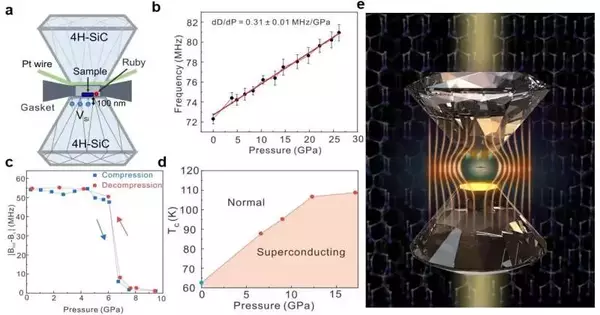A research platform for studying superconducting magnetic detection and magnetic phase transitions of hydrides under high pressure has been developed by a collaborative research team from the Hefei Institutes of Physical Science of the Chinese Academy of Sciences (CAS) and the University of Science and Technology of China, according to a study that was published in Nature Materials.
It has been difficult to measure magnetic fields in situ at high pressure with high resolution. The Meissner effect of superconductivity and the behavior of magnetic phase transitions under high pressure have been hampered as a result. On diamond nitrogen vacancy (NV) centers, the optically detected magnetic resonance (ODMR) method has assisted in the in-situ detection of pressure-induced magnetic phase transitions. However, zero-field splitting is temperature-dependent, and the NV center has four axial directions, making it difficult to analyze and interpret the measured ODMR spectra.
The problem of high-pressure magnetic detection has been solved, and high-pressure in-situ quantum magnetic detection based on silicon vacancy (VSi) defects in silicon carbide has been realized for the first time in this study.
The researchers created shallow VSi defects on the surface of a processed silicon carbide anvil cell by ion implantation. In silicon carbide, VSi defects only have one axial direction. Zero-field splitting is insensitive to temperature because of the unique symmetry of the electronic structure of silicon carbide. As a result, the issue of temperature variations in high-pressure sensing can be avoided.
The zero-field splitting value of VSi defects was found to shift blue with pressure (0.31 MHz/GPa), significantly less than the slope of diamond NV centers (14.6 MHz/GPa). Under high pressure, this is helpful for measuring and analyzing ODMR spectra.
The researchers measured the critical temperature-pressure phase diagram of the YBa2Cu3O6.6 superconductor and observed the pressure-induced magnetic phase transition of Nd2Fe14B magnets at approximately seven GPa using ODMR technology on VSi defects.
According to the researchers, the fields of high-pressure superconductivity and magnetic materials greatly benefit from this method.
This work opens the door to new research on quantum materials made possible by Moissanite anvil cells by demonstrating that room-temperature spin defects in silicon carbide can be used as in-situ high-pressure sensors.
More information: Xiao-Di Liu, Magnetic detection under high pressures using designed silicon vacancy centres in silicon carbide, Nature Materials (2023). DOI: 10.1038/s41563-023-01477-5. www.nature.com/articles/s41563-023-01477-5





